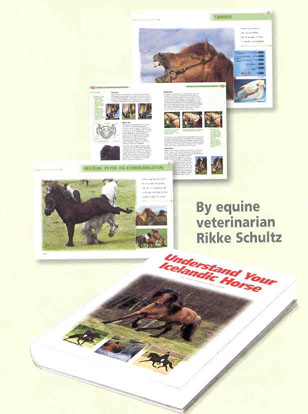|
     
"Understand Your Icelandic Horse"
By Rikke Schultz, Author and Veterinarian
 Communication is of the utmost importance if horse and rider are to function as harmoniously as possible. It may be difficult to interpret the horse's reactions, if he runs away, flicks his tail, is difficult to lead or fidgety during mounting. The book deals with the issues of communication between horse and rider as well as a large number of ailments and conditions rendering the horse unable to do as the rider desires.
Communication is of the utmost importance if horse and rider are to function as harmoniously as possible. It may be difficult to interpret the horse's reactions, if he runs away, flicks his tail, is difficult to lead or fidgety during mounting. The book deals with the issues of communication between horse and rider as well as a large number of ailments and conditions rendering the horse unable to do as the rider desires.
A brief summary of the individual chapters:
- THE HORSE'S MENTALITY AND COMMUNICATION
The chapter describes the horse's natural flight instinct and the reactions of the nervous system as well as the mode of communication between horse and human.
- REDUCED PERFORMANCE
This chapter deals with the symptoms of the horse, when it is unable to fulfil the rider's wishes and demands.
- TEETH
The dental care of the horse is very important. Read about the various dental problems horses suffer from and the symptoms and riding problems they cause.
- THE SPINAL COLUMN
The chapter describes the diseases of the spinal column and the pelvis, including many problems which can be treated by acupuncture and manipulation. Gait difficulties which may arise are also described.
- THE MUSCLES
The composition and training physiology of the muscles as well as various muscular problems are examined.
- LAMENESS
The most common causes of lameness in Icelandic horses are described as well as their influence on the gaits.
- THE HOOVES, TRIMMING AND SHOEING
"No hoof no horse". Incorrect trimming and shoeing can cause a lot of unsoundness and reduce the horse's performance extensively. Also read about the various types of corrective shoes.
- OTHER PERFORMANCE REDUCING AILMENTS
Read in this chapter about issues that render the horse unable to carry out the expected work e.g. low haemoglobin count eating sand , ulcers and respiratory problems.
- THE RIDER
The rider and the horse must be suited for each to form a great team. Read about the rider's shortcomings and mistakes and find some solutions from the "Centred Riding" method by Sally Swift.
- SADDLE FIT
Finding the correct saddle for the horse is a science in itself. Read about what to look for and which problems can arise if the saddle doesn't fit.
- BITS AND AUXILIARY REINS
How does the bit really function? How are the tongue and forelegs connected? What are the direct and indirect effects ofthe bit?
- TRAINING METHODS
When the horse is asked to perform at his best, the training needs to be in order. Read about the importance of confidence between horse and rider, about the TTEAM training methods and rehabilitation after illness or injury.
- EXAMINATION METHODS
Which examination methods should be applied to the horse? Read about the situations where X-ray, thermography and ultrasound scanning are indicated.
- TREATMENT METHODS
Having established a diagnosis the horse should be treated. Read about joint treatments, acupuncture, chiropractic and some of the exercises of the TTEAM Method.
- HOW TO BUY A HORSE
It is difficult to choose a new horse. Get some advice on what to look for and read about the veterinarian's purchase examination, insurance and what is done when the horse has to pass on to the eternal happy meadow.
 Order Book Order Book |
 About Rikke Schultz About Rikke Schultz |
 Read A Chapter Read A Chapter |
|
